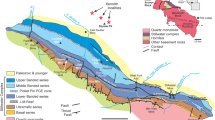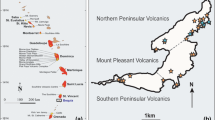Abstract
The products emitted by Mount Etna in the 1977–1983 period are porphyric, sodic trachybasalts («etnaïtes») that, though substantially higher in K2O, resemble most of the historic lavas.
The 1983 flows, for instance, are composed of 50–55% glassy groundmass and abundant phenocrysts or microphenocrysts: plagioclase (25–30%), clinopyroxene (12–15%), olivine (3–5%), titanomagnetite (2%). Scarce olivine Fo 83-78 and diopsidic pyroxene are present in the cores of some phenocrysts. Outer zones and/or more numerous crystals are olivine Fo 75-68, salite En 43-37 Fs 10-15, plagioclase An 83-55 an Al-Mg rich magnetite Usp 43-33. The chemical composition of glass inclusions interpreted as trapped liquids suggests that olivine and magnetite crystallize first and are followed by pyroxene and plagioclase. The early appearance of olivine has been determined by optical thermometry to about 1170°C, soon followed by plagioclase and pyroxene (1160–1140°C). Pre-eruptive crystallization further progresses until 1073°C which is the field-measured temperature at the lava vent. Then, the appearance and composition of microlites (and outer rims of phenocrysts) depend upon the cooling rate of the samples (water quenching or natural cooling). Electron microprobe analyses of chlorine and sulphur have been performed on crystal trapped and groundmass glasses. Sulphur ranges from an initial content of 1500 ppm to 400 ppm in residual glass, leading to an average sulphur emission of 1500 tons/day (3000 t/d SO2), as estimated from the volume of erupted lava.
The most striking chemical feature of the 1977–1983 lavas lies in the abnormal potassium behaviour, especially in the earliest flows of the 1978–1979 fissure eruptions. Although these lavas are amongst the most femic of the period, they are relatively high in K2 O, leading to an aberrant K/Na ratio (i.e. increasing with increasing basicity). Furthermore, a less pronounced but steady increase of K2 O/Na2 O is evidenced in all the lavas of the past 12 years. This ratio ranges from 0.42 in the 1971 lavas to 0.51 in the 1983 ones, for about the same differentiation index. Such an abnormal potassium behaviour first appeared during the 1974 eruption on the west slope of the volcano. It is unknown, however, in any other historic lava, nor in any lava of entire Etna so far analyzed.
Resume
Les produits rejetés par l'Etna de 1977 à 1983 sont des trachybasaltes porphyriques («etnaïtes») semblables à ceux qui caractérisent la majorité des laves de ce volcan, mais avec une teneur en K plus élevée.
Les coulées de 1983, par exemple, sont formées de 50–55% de mésostase et par de nombreux phéno et microphénocristaux de plagioclase (25–30%), clinopyroxène (12–15%), olivine (3–5%), titanomagnétite (2%). De l'olivine Fo 83-78 et un peu de diopside-salite cristallisent d'abord, passant rapidement à une olivine Fo 78-68, une salite (Wo 47,5 — En 43/37 — Fs 10/15), du plagioclase An 83-55, une titanomagnétite Usp 43-33 riche en Al et Mg. Le domaine de température de cristallisation commençante des phénocristaux établi par thermométrie optique est compris entre 1170° et 1140°C. La cristallisation intratellurique progresse ensuite jusqu'à 1073°C, qui représente la température d'émission de la lave mesurée sur le terrain. La nature et la quantité des microlites, la composition des stades terminaux de cristallisation des phénocristaux et celle du verre résiduel de la mésostase dépendent du mode de refroidissement de la lave: trempe à l'eau, à l'air, ou refroidissement lent naturel. La quantité de soufre dans les verres inclus et la mésostase varie de 1500 à 400 ppm, celle du chlore de 1700 à 2800 ppm.
La composition chimique est celle d'un trachybasalte sodique (hawaiite basaltique). Le caractère le plus marquant réside dans le comportement anormal du potassium, en particulier dans les laves du début des éruptions de 1978 et 1979. Alors que ces produits sont parmi les plus basiques de la période considérée, leur teneur en K est relativement élevée, ce qui conduit à un rapport K/Na aberrant (augmentant avec la basicité de la roche). En dehors de ces cas extrêmes, on note une augmentation régulière, quoique plus faible, de K/Na dans tous les produits des 12 dernières années. Ce comportement anormal du potassium était déjà apparu dans les produits de l'éruption excentrique de 1974 sur le versant ouest. Cependant, on ne trouve aucune variation aberrante du potassium dans les autres laves historiques, ni même dans aucun des produits connus de l'Etna.
Similar content being viewed by others
References
Archambault C., Tanguy J. C., 1976,Comparative Temperature Measurements on Mount Etna Lavas: Problems and Techniques. J. Volc. Geotherm. Res.1, p. 113–125.
Bizouard H., Metrich N., Clocchiatti R., 1982,Essai de dosage par microsonde éléctronique de quelques éléments volatils (Cl, F, S) dans les liquides silicatés intra et intercrystallins. Bull. PIRPSEV,49, p. 1–9.
Clocchiatti R., 1975,Les inclusions vitreuses du quartz: données optiques, thermométriques et chimiques. Mém. Soc. Géol. Fr.,122, p. 1–96.
--,Metrich N., 1984,Témoignages de la contamination dans les produits des éruptions explosives des M. Silvestri (1892) et M. Rossi (1669) (M. Etna), Bull. Volcanol., this volume.
Cristofolini R., Romano R., 1982,Petrologic Features of Etnean Volcanic Rocks. Mem. Soc. Geol. It.,23, p. 99–115.
Joron J. L., Treuil M., 1984,Géochimie des laves récentes de l'Etna. Leur place dans l'évolution du volcan. In preparation.
Haulet R., Zettwoog P., Sabroux J. C., 1977,Sulphur Dioxide Discharge from Mount Etna. Nature,268, 5622, p. 715–717.
Malinconico L. L., Jr, 1979,Fluctuations in SO 2 Emission During Recent Eruptions of Etna. Nature,268, 5699, p. 43–45.
Rittmann A., 1960,Vulkane und ihre Tatigkeit. F. Enke, Stuttgart.
Rose W. I., Stoiber R. E. andMalinconico L. L., 1982,Eruptive Gas Compositions and Fluxes of Explosive Volcanoes: Budget of S and Cl Emitted from Fuego Volcano, Guatemala. In:Andesites (R. S. Thorpe), p. 669–676.
Sean Bull., 1983, Smithsonian Institution, Washington D.C. 20560,8, n. 4-5-6.
Tanguy J. C., 1966,Les laves récentes de l'Etna. Bull. Soc. Geol. Fr., ser. 7,VIII, p. 201–217.
Tanguy J. C., 1973,The 1971 Etna Eruption: Petrography of the Lavas. Phil. Trans. R. Soc. London,A 274, p. 45–53.
——, 1978,Tholeiitic Basalt Magmatism of Mount Etna and Its Relations with the Alkaline Series. Contr. Miner. Petr.,66, p. 51–67.
--,, 1980,L'Etna, étude pétrologique et paléomagnétique: implications volcanologiques. Thèse doctorat ès Sciences. Univ. Paris 6, 618 pp.
——, 1976,The 1974 Eruption of Mount Etna. Bull. Volcanol.,40–4, p. 239–253.
--,,Patane G., 1984,Activity of Mount Etna, 1977–1983: Volcanic Phenomena and Correlated Seismic Tremor. Bull. Volcanol., this volume.
Watson E. B., 1982,Basalt Contamination by Continental Crust: Some Experiments and Models. Contr. Miner. Petr.,80, p. 73–87.
Wright T. L. andDoherty P. C., 1970,A Linear Programming and Least Squares Computer Method for Solving Petrologic Mixing Problems. Geol. Soc. Amer. Bull.,81, p. 1995–2008.
Author information
Authors and Affiliations
Rights and permissions
About this article
Cite this article
Tanguy, J.C., Clocchiatti, R. The Etnean Lavas, 1977–1983: Petrology and mineralogy. Bull Volcanol 47, 879–894 (1984). https://doi.org/10.1007/BF01952349
Received:
Revised:
Issue Date:
DOI: https://doi.org/10.1007/BF01952349




